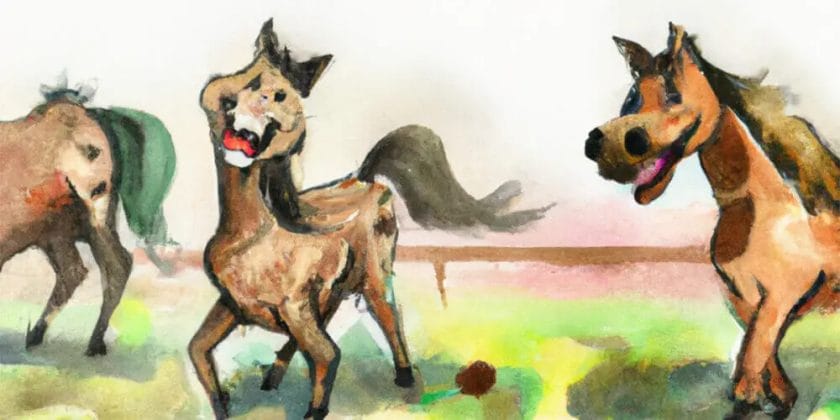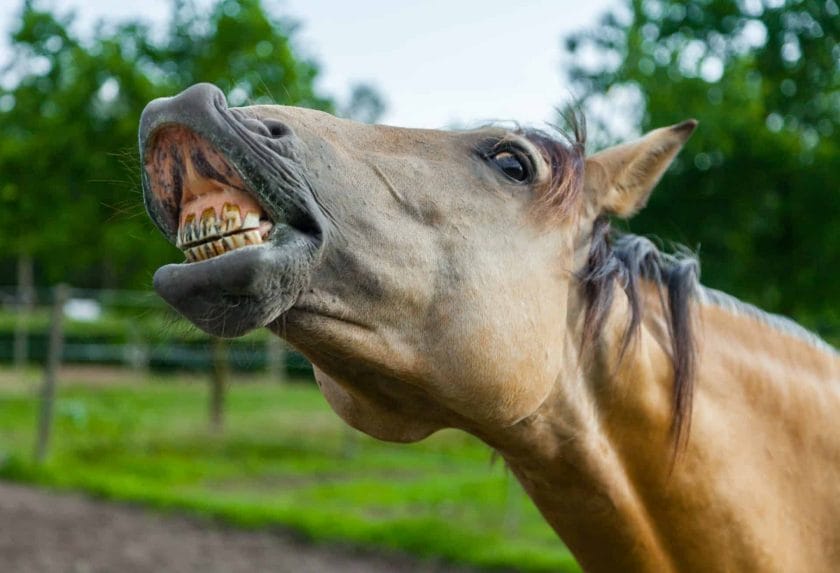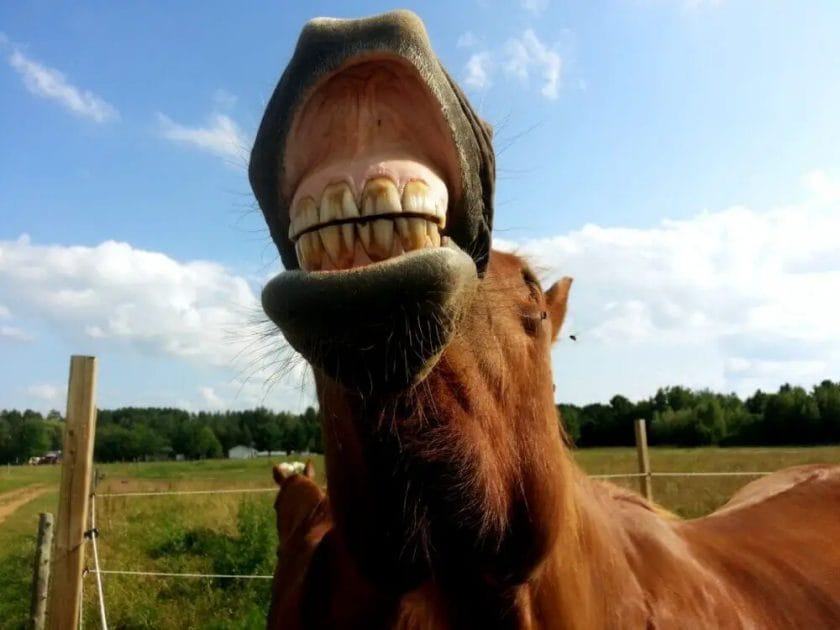Horses smiling may seem like a whimsical concept, but in reality, horses do not possess the facial muscles required to express human-like emotions. However, horses can display signs of contentment and relaxation through their body language. By understanding their natural behaviors, such as relaxed ears, soft eyes, and a lowered head, we can interpret these as signs that a horse is feeling comfortable and at ease.
Furthermore, horses often respond positively to positive interactions with humans, which can create a bond and lead to joyful moments between horse and rider. Whether it’s during grooming, training sessions, or simply spending time together, these experiences can bring out expressions of happiness in horses.
It’s important to remember that horses have their own unique ways of communicating and showing emotions. So, while horses may not physically smile as we do, their expressions of contentment and happiness can shine through their body language and their interactions with humans.

The Emotional Connection: Understanding the Significance of Horse Smiles in Human-Horse Relationships
When it comes to building a strong bond with horses, understanding their communication cues is essential. While horses may not be able to speak in words, they have their unique ways of expressing themselves. One such expression that has intrigued equestrians and researchers alike is the horse smile. In this section, we will delve deeper into the significance of horse smiles in human-horse relationships.
1. What is a horse smile?
A horse smile, also known as a flehmen response, is a facial expression displayed by horses. It involves the horse curling its upper lip and exposing its teeth, typically accompanied by a curious tilt of the head. This behavior may appear unusual to some, but it holds great meaning in the realm of horse communication.
2. Why do horses smile?
The primary purpose of a horse smile is to engage in the process of scent detection. Horses possess a specialized olfactory system, and by lifting their upper lip, they can direct scents to a structure called the vomeronasal organ, located in the roof of their mouth. This organ helps them analyze and gather information about their surroundings, including potential mates, food sources, and even the emotional state of other horses.
3. The social significance of horse smiles
While the flehmen response is primarily linked to scent detection, it also holds social significance in the context of human-horse relationships. Horses are highly social animals, and their ability to form deep emotional connections with humans is well-documented. Smiling can be an indicator of trust and comfort in the presence of a human companion.
4. Interpreting horse smiles
Understanding the meaning behind a horse smile can be a valuable tool for horse owners and enthusiasts. Here are a few possible interpretations:
- Curiosity: A horse smile accompanied by a tilted head can signify curiosity about a particular scent or object.
- Relaxation: If a horse displays a smile while being groomed or receiving affection, it may indicate a state of relaxation and contentment.
- Trust: A horse that smiles in the presence of its human handler may be expressing a high level of trust and comfort.
5. Strengthening the bond through understanding
By recognizing and responding appropriately to a horse smile, humans can strengthen their emotional connection with their equine partners. Responding positively to a horse’s curiosity or providing comfort in moments of relaxation can deepen the bond and foster a sense of trust between horse and rider.
In summary, horse smiles, or flehmen responses, play a vital role in horse communication and human-horse relationships. They serve as a means of scent detection and can also convey social messages such as curiosity, relaxation, and trust. Understanding and interpreting horse smiles can help equestrians build a stronger emotional bond with their horses, leading to a more harmonious and fulfilling partnership.

The Role of Facial Muscles: Exploring the Anatomy behind Horses’ Ability to Smile
When we think of a smiling face, horses are probably not the first creatures that come to mind. However, believe it or not, horses have the ability to exhibit a facial expression that closely resembles a smile. In this section, we will delve into the fascinating anatomy of horses’ facial muscles and explore how they contribute to this unique phenomenon.
The Facial Muscles in Horses
Horses, like humans and many other mammals, possess a complex network of facial muscles that allow them to convey various emotions and expressions. These muscles are responsible for controlling the movement and positioning of different parts of the horse’s face, including the lips, nostrils, and eyes.
One of the key muscles involved in a horse’s ability to smile is the levator labii superioris muscle. This muscle runs along the upper lip and is responsible for lifting the lip upwards, creating the appearance of a smile. The zygomaticus muscles, located on either side of the face, also play a crucial role in forming the characteristic curved shape of the smile.
The Function of the Facial Muscles in Smiling
While the concept of a horse smiling may seem anthropomorphic, there is evidence to suggest that these facial expressions serve a functional purpose for horses. When a horse is relaxed, content, or experiencing pleasure, it may exhibit a facial expression that resembles a smile. This expression is often accompanied by other signs of relaxation, such as softening of the eyes and lowering of the head.
Research suggests that horses may use their smiles as a way to communicate their emotional state to other horses and even humans. When a horse is feeling calm and happy, its smile can be an indication of its overall well-being. Similarly, horses may respond positively to human interactions when they perceive a friendly and calm demeanor.
The Significance of Smiling in Horsemanship
Understanding the role of facial expressions, including smiling, in horses can have practical implications in horsemanship. Recognizing when a horse is genuinely happy and relaxed can help horse owners and trainers gauge the animal’s emotional state and well-being. It can also aid in building trust and rapport between horses and humans, as a horse that feels understood and respected is more likely to form a positive bond.
Moreover, studying the facial anatomy and expressions of horses can contribute to the overall knowledge of equine behavior and welfare. By gaining a deeper understanding of how horses communicate through facial expressions, researchers and veterinarians can improve the way they assess the mental and emotional state of these magnificent animals.
In Summary
Horses possess a unique ability to smile, thanks to the intricate network of facial muscles that allow them to manipulate their expressions. The levator labii superioris and zygomaticus muscles are particularly important in creating the smiling appearance in horses. Smiling in horses serves as a form of communication, indicating their emotional state. Understanding and recognizing these expressions can play a crucial role in horsemanship, enhancing the relationship between humans and horses, and furthering our understanding of equine behavior and welfare.

4. The Power of Positive Reinforcement: How Training Techniques Can Influence Horses’ Smiling Behavior
Training horses is not just about teaching them commands and tricks; it is also about developing a positive and trusting relationship with these magnificent creatures. Horses are highly intelligent and emotional animals, and their behavior can be influenced by the training techniques used by their handlers. One fascinating behavior that can be influenced through training is a horse’s smiling behavior.
Smiling behavior in horses refers to the relaxed and content facial expression that resembles a smile. It is an indication that the horse is comfortable and feels safe in its environment. While horses naturally exhibit this behavior during moments of relaxation, it can also be enhanced through positive reinforcement training techniques.
Positive reinforcement involves rewarding desired behaviors to encourage their repetition. In the context of horse training, this can be done through the use of treats, praise, or even a gentle pat on the neck. By associating the desired behavior, such as staying calm or following commands, with a positive reward, horses learn to associate these actions with a pleasant experience.
When it comes to influencing a horse’s smiling behavior, positive reinforcement training techniques can play a significant role. By rewarding a horse’s relaxed and content facial expression, trainers can reinforce and encourage this behavior. For example, when a horse naturally exhibits a smile, the trainer can offer a treat or praise to reinforce the behavior. Over time, the horse will learn to associate the smiling behavior with positive rewards and will be more likely to exhibit it in the future.
It is important to note that positive reinforcement should be used consistently and appropriately. Trainers should reward the horse’s smiling behavior when it occurs naturally and not force or manipulate the horse’s facial expression. The goal is to create a positive and trusting relationship between the horse and trainer, where the horse feels comfortable expressing itself.
In addition to positive reinforcement, other training techniques can also influence a horse’s smiling behavior. These include desensitization exercises, which help the horse become more comfortable with various stimuli and environments. By gradually exposing the horse to different situations and rewarding calm and relaxed behavior, trainers can help the horse develop a positive outlook and a natural tendency to smile.
Furthermore, the overall training approach and atmosphere can also have an impact on a horse’s smiling behavior. Horses are highly sensitive animals and can pick up on the emotions and energy of their trainers. Creating a calm and positive training environment, where the horse feels safe and valued, can contribute to the development of a horse’s smiling behavior.
In summary, training techniques can have a profound influence on a horse’s smiling behavior. Through the use of positive reinforcement, desensitization exercises, and creating a positive training environment, trainers can encourage horses to exhibit relaxed and content facial expressions resembling a smile. This not only enhances the bond between horse and trainer but also promotes the well-being and happiness of the horse. By understanding and utilizing the power of positive reinforcement, trainers can unlock the true potential of these magnificent animals.
5. The Joy of Equine Communication: Interpreting Horses’ Smiles as a Form of Expression
Horses have long been admired and revered for their beauty, grace, and strength. They are magnificent creatures that have captivated humans for centuries. But did you know that horses also communicate with us through subtle facial expressions, including smiles?
In this section, we will explore the fascinating world of equine communication and delve into the meaning behind horses’ smiles. We will uncover the secrets of this unique form of expression and discover how it can deepen our bond with these majestic animals.
The Language of Horses
Just like humans, horses have their own language. They use a combination of body language, vocalizations, and facial expressions to convey their thoughts, feelings, and intentions. While we may be more familiar with their body language and vocalizations, their facial expressions often go unnoticed or misunderstood.
One of the most intriguing aspects of equine facial expressions is the smile. While it may be easy to dismiss a horse’s smile as a random occurrence or a result of physical comfort, research suggests that it holds a deeper meaning.
Interpreting Horses’ Smiles
When a horse smiles, it is not simply a display of happiness or contentment. It is a form of communication that can signify various emotions and intentions. By understanding and interpreting horses’ smiles, we can gain valuable insights into their state of mind and build a stronger connection with them.
Here are a few possible interpretations of horses’ smiles:
- Relaxation and Contentment: A horse may smile when they are at ease, comfortable, and content in their environment.
- Playfulness: Horses sometimes smile when they are in a playful mood, indicating their desire to engage in social interactions or games.
- Pain or Discomfort: In some cases, a horse’s smile may indicate discomfort or pain. It could be a subtle way for them to communicate their need for attention or medical assistance.
- Submission: When a horse displays a soft, gentle smile, it can be a sign of submission or deference to a dominant individual within their herd.
It is important to note that interpreting horses’ smiles requires a holistic understanding of their body language, vocalizations, and overall behavior. It is not solely based on the presence of a smile but rather a combination of factors.
Building a Connection through Smiles
Recognizing and understanding horses’ smiles allows us to forge a deeper connection with these magnificent creatures. By paying attention to their facial expressions, we can better respond to their needs, emotions, and desires.
Here are a few tips for building a stronger connection through smiles:
- Observation: Take the time to observe your horse closely and familiarize yourself with their unique facial expressions.
- Trust: Building trust is crucial in any human-animal relationship. By responding to your horse’s smiles with care and attention, you can establish a foundation of trust.
- Communication: Use positive reinforcement and clear communication to reinforce desired behaviors and strengthen your bond.
- Training: Training your horse with patience, consistency, and respect can help them feel more comfortable expressing themselves through smiles.
In Summary
Horses’ smiles are not mere coincidences or simple physical reactions. They are a form of expression that carries meaning and allows us to delve deeper into their emotions and intentions. By learning to interpret these smiles and building a connection through them, we can enhance our relationship with these magnificent creatures and experience the true joy of equine communication.
FAQs
Why do horses smile?
Horses do not smile in the same way humans do. The appearance of a “smile” on a horse’s face is typically a result of their natural facial structure and expressions. In some cases, a horse may appear to be smiling when they are relaxed or content.
Conclusion:
In conclusion, the concept of horses smiling is an intriguing one. While horses may appear to be smiling due to the shape of their lips or the positioning of their facial muscles, it is important to note that horses do not express emotions in the same way humans do. Their facial expressions are primarily related to physical comfort and communication among themselves.
While some may argue that horses smile in response to positive interactions with humans, further research is needed to support this claim. It is crucial to remember that understanding the behavior of horses requires a holistic approach, taking into consideration their body language, vocalizations, and overall demeanor. So, the next time you see a horse seemingly smiling, appreciate the beauty of these majestic creatures and their unique way of communicating.
Overall, the idea of horses smiling remains a topic of fascination, but it is essential to approach it with scientific knowledge and an appreciation for the complexity of equine behavior.
